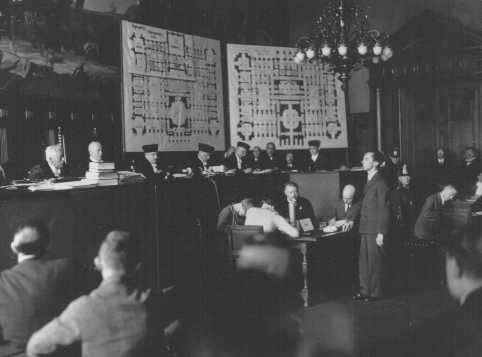
Law for the Imposition and Implementation of the Death Penalty
The Law for the Imposition and Implementation of the Death Penalty was one of a series of key decrees, legislative acts, and case law in the gradual process by which the Nazi leadership moved Germany from a democracy to a dictatorship.
Background
The Nazi state enacted the Law for the Imposition and Implementation of the Death Penalty on March 29, 1933, just a month after the Reichstag fire. Its first stipulation made a key article of the Reichstag Fire Decree—that which changed the punishment for certain crimes such as arson and high treason from life in prison to the death penalty—retroactive to the beginning of Hitler's assumption of power. This violated the ex post facto rule of law and ensured that those who were accused of setting fire to the Reichstag would be executed if convicted. The second article allowed the execution itself to be carried out by hanging, considered a harsh and shameful mode of execution, in place of beheading.
In fact, Hitler pressed for this law, also known as Lex van der Lubbe, for purely political reasons. He insisted upon the death penalty to underscore the legitimacy of the regime's claim that the fire had been an act of rebellion against the state. This was all the more important since Hitler had used the fire to declare a state of emergency. This in turn allowed him to abolish many longstanding constitutional guarantees. Working backward, the execution of the alleged perpetrators of the Reichstag arson would justify to the public the extreme measures that the Nazi regime had put into place.
The Supreme Court's decision in the case reveals the ambivalence and complexity of its role in the new Nazi regime. On the one hand, the court found Marinus van der Lubbe guilty and permitted his hanging, accepting the unilateral changes to the constitution that Hitler's government had enacted. On the other hand, it found van der Lubbe's codefendants not guilty of the crime of arson, rejecting the notion of “political necessity” as an overriding factor in deciding the verdict. In this regard, the court declared that it would not be used to stage politically important show trials. An outraged Hitler removed jurisdiction for political crimes from the Supreme Court and established the so-called People's Court (Volksgericht) in Berlin instead, appointing Nazi judges to the bench to ensure the outcome of such cases in the future.
Translation
Translated from Reichsgesetzblatt I, 1933, Nr. 28, p. 151.
The Reich Government has decided the following law that is hereby proclaimed:
Article 1
Section 5 of the Decree of the Reich President for the Protection of the People and the State of February 28, 1933 (RGBL I, page 83) applies also to acts committed between January 31 and February 28, 1933.
Article 2
If someone should be sentenced to death due to conviction of a crime against public security, the Reich or state authority responsible for carrying out the sentence can order the sentence carried out by hanging.
Article 2 is a revision of Section 13 of the Criminal Code for the German Reich of May 15, 1871 (RGBL I, page 127), which determined that the death penalty is to be carried out through beheading.
Reich Chancellor: Adolf Hitler
For the Reich Minister of Justice: Deputy Reich Chancellor v. Papen
Critical Thinking Questions
What pressures and motivations may have affected members of the legal profession as the Nazi government consolidated its power in the 1930s?
What is the appropriate relationship between a government and the judiciary?
What is the appropriate relationship between ideology and the judiciary?

